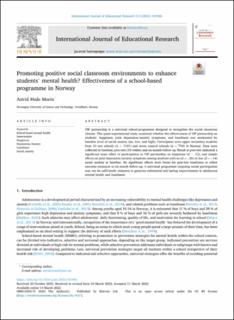| dc.contributor.author | Morin, Astrid Hoås | |
| dc.date.accessioned | 2023-03-21T07:33:18Z | |
| dc.date.available | 2023-03-21T07:33:18Z | |
| dc.date.created | 2022-03-15T12:57:21Z | |
| dc.date.issued | 2022 | |
| dc.identifier.citation | International Journal of Educational Research. 2022, 113 . | en_US |
| dc.identifier.issn | 0883-0355 | |
| dc.identifier.uri | https://hdl.handle.net/11250/3059399 | |
| dc.description.abstract | VIP partnership is a universal school-programme designed to strengthen the social classroom climate. This quasi-experimental study examined whether the effectiveness of VIP partnership on students’ happiness, joint depression/anxiety symptoms, and loneliness was moderated by baseline level of social anxiety (no, low, and high). Participants were upper secondary students from 10 test schools (n = 1101) and seven control schools (n = 734) in Norway. Data were collected at baseline, post-test (10 weeks) and six-month follow-up. Result at post-test indicated a significant main effect of participation in VIP partnership on happiness (d = .12), and simple effects on joint depression/anxiety symptoms among students with no (d = -.30) or low (d = -.14) social anxiety at baseline. No significant effects were found for post-test loneliness or either outcome measures at six-month follow-up. A universal programme targeting social participation may not be sufficiently intensive to generate substantial and lasting improvements in adolescent mental health and loneliness. | en_US |
| dc.language.iso | eng | en_US |
| dc.publisher | Elsevier | en_US |
| dc.rights | Navngivelse 4.0 Internasjonal | * |
| dc.rights.uri | http://creativecommons.org/licenses/by/4.0/deed.no | * |
| dc.title | Promoting positive social classroom environments to enhance students’ mental health? Effectiveness of a school-based programme in Norway | en_US |
| dc.title.alternative | Promoting positive social classroom environments to enhance students’ mental health? Effectiveness of a school-based programme in Norway | en_US |
| dc.type | Peer reviewed | en_US |
| dc.type | Journal article | en_US |
| dc.description.version | publishedVersion | en_US |
| dc.source.pagenumber | 14 | en_US |
| dc.source.volume | 113 | en_US |
| dc.source.journal | International Journal of Educational Research | en_US |
| dc.identifier.doi | 10.1016/j.ijer.2022.101966 | |
| dc.identifier.cristin | 2009946 | |
| cristin.ispublished | true | |
| cristin.fulltext | original | |
| cristin.qualitycode | 2 | |

